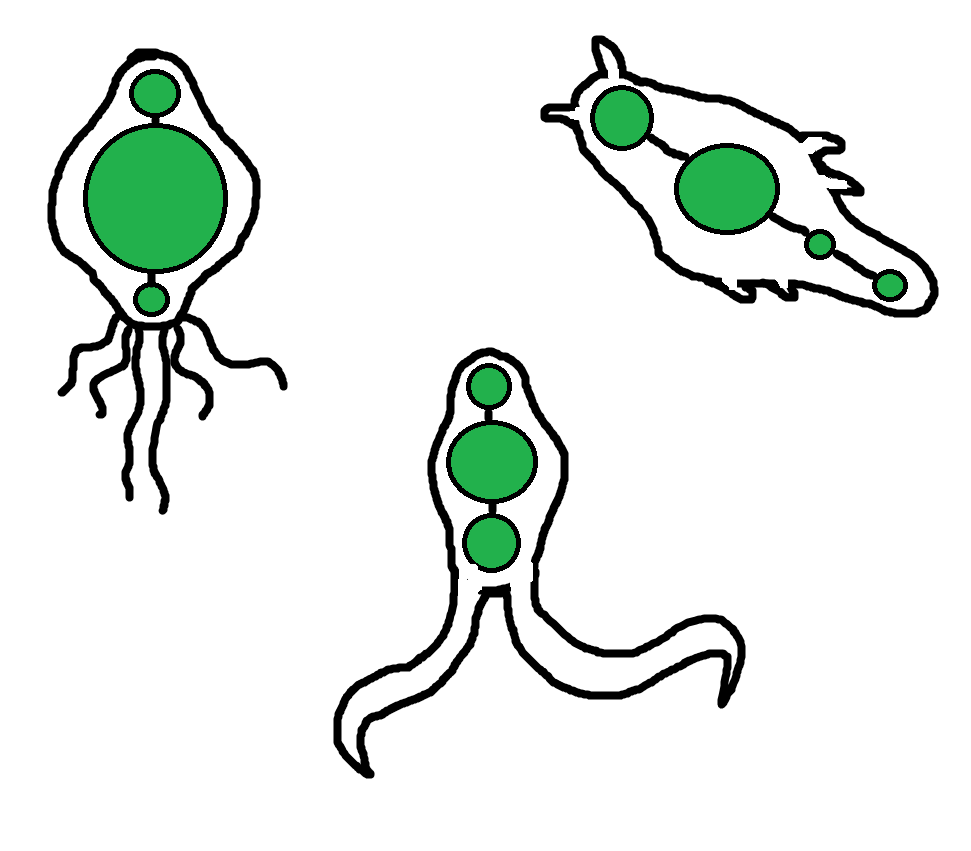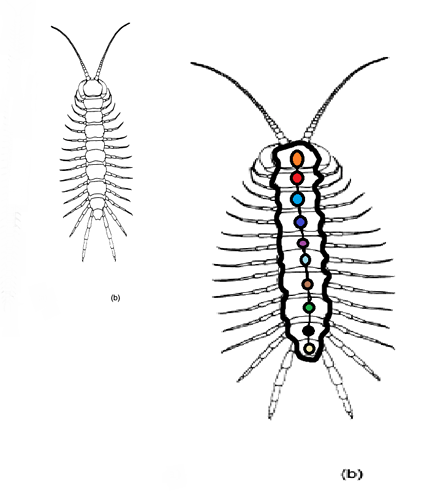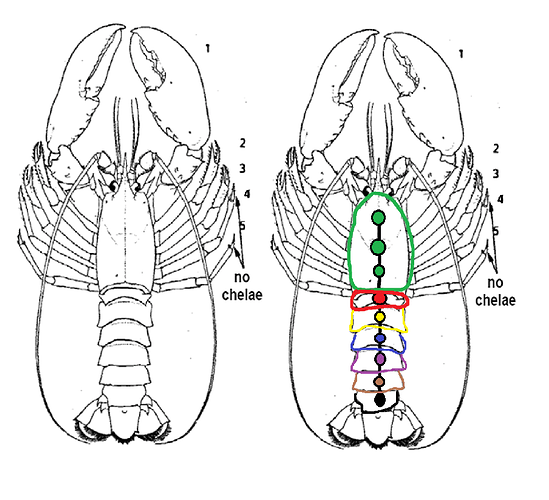Fleshing Out Hydrostatic Skeletons, Endoskeletons, and Exoskeletons
In an effort to create greater clarity on our plans for the macroscopic stages and seeing as the base of this concept seems to be well-received, I would like to jot out some thoughts I’ve had building on this base concept. Insight and opinion is, of course, very much welcomed.
Looking at metazoans, there are various methods through which organisms “create” structure in their body plan. A large majority of diverse animal groups are soft-bodied creatures, typically relying on a hydrostatic skeleton with no solid objects to root things like muscles on. Vertebrata utilize an endoskeleton, with an internal bone structure as a root for muscles and more advanced organ systems. And there are exoskeletal creatures, such as arthropods, who utilize an exoskeleton to give themselves form. Note that another major structural group are shelled organisms, such as snails and other molluscs, that utilize a hard substance as a structural anchor as well; but those are technically considered to be soft-shelled creatures with unique adaptations.
Those different types of structures come with their own costs and benefits, and define heavy implications on morphology. Organisms with an exoskeleton demonstrate a heavy level of segmentation due to their rigid bodies. Their genome has adapted towards this explicit segmentation, allowing them to replicate limb structure much more easily than a vertebrate genome can - the latter needing to ensure that multiple resource-intensive organ systems coordinate to create a functioning limb. However, organisms with exoskeletons face limitations with their size on land, need to molt, and require special adaptations to ensure a proper exchange of gas and adequate sensory information. Organisms with an endoskeleton, such as vertebrates, are much more resilient against the square-cube law, allowing them to deal much more easily with size.
Exoskeleton (Arthropods)
Pros
Segmentation Means More Replicable Parts - Segmentation is a lot more explicit in arthropods than in other organisms, with each segment being its own defined part of a body (thorax, head, abdomen, etc.). The arthropod genome has structured itself around this segmentation, meaning genetic material for a limb can essentially be “copied” much more easily than it might be for a vertebrate, allowing arthropods the ability to have a large number of limbs and appendages.
Greater Protection From Environment - A tough external coat of armor surrounding the entire body protects from blunt trauma and predation.
Easier to Keep Moisture In - It is much easier to keep moisture within a solid and rigid object than it is for a continuously exchanging medium, such as skin. This effectively means it is easier for arthropods to make the transition from water to land, and vice versa.
Cons
A Lack of Flexibility - Because the entire body is covered by a chitinous coat of armor, arthropod joints tend to have much less dynamic flexibility than a ball-and-socket joint in vertebrates have. This can limit speed and agility.
Molting - A rigid exoskeleton cannot continuously grow alongside an organism, so it must be shed every once in a while. Not only does this leave an organism vulnerable to predation, but it requires intense effort and can potentially take away from efforts to gather food and other resources.
Limited Size And Less Force Potential - Compared to an endoskeleton, an exoskeleton is much more subject to the square-cube law. Not only does this mean that arthropods cannot grow as large as other organisms, but should they theoretically reach that size, they would not be able to exert the same amount of force on their skeleton as a vertebrate might.
Gaseous Exchange Limitations - The same property of a chitinous membrane that allows them to retain moisture better than other organisms also limits gaseous exchange between an arthropod’s internal systems and the environment. This means less efficient respiration, which essentially means limitations to sizing up on land.
Endoskeleton (Vertebrates)
Pros
Happy Mediums - Organisms with an endoskeleton receive the benefits of having a robust skeletal structure, but are not as constrained than organisms with an exoskeleton in terms of movement and flexibility. They are also able to maintain gaseous exchange through skin, meaning a capacity for efficient respiration remains.
Greater Capacity for Size - Internal skeletons are much more capable of accomodating the square cube law than an exoskeleton, meaning a greater capacity for attaining size and preserving strength at said size.
Greater Force and Flexibility Capability - Being less rigid than an exoskeleton, endoskeleton-bearing organisms are able to exert force at a more dynamic joint range. This allows for greater strength, size, and other forms of force projection at size.
Cons
More “Set” Body Plan - Especially at larger sizes, it takes a lot to make an endoskeleton work properly. Because of this, rather than “simple” replications of segments as seen in arthropods, stem cells in a vertebrate embryo have to carefully coordinate expression so that development proceeds as needed. This essentially means that appendages aren’t as easily replicable in vertebrates as they are for exoskeletons.
Vulnerability of Exposed Skin - A greater capacity for gas exchange means a greater need for protection against the elements. This means the initial transition to land is harder for vertebrates than it might be for arthropods.
Hydrostatic Skeletons (Soft-Bodied)
Pros
Much Use, Little Resources - Soft-bodied organisms are able to conduct a great amount of their biological processes through simple membrane gas-exchange. They are also able to maintain structural integrity without need for dense skeletal structures, relying only on the presence of fluid/water. This allows great regenerative capabilities and requires little structural complexity. It also means a great amount of diversity in terms of soft-bodied body plans: jellyfish, octopi, molluscs as a whole, and all sorts of worms utilize soft-bodied skeletons.
Incredible Flexibility - A soft-bodied organism is able to fit through any crevice as long is said crevice is bigger than any potential hard-body structure (octopi beak, shells, etc.). This allows strong tunneling abilities, and allows organisms to hide in very discrete areas.
Lightweight Buoyancy - Lacking a dense skeletal structure, soft-bodied organisms don’t need as many adaptations should they be filling a niche near the ocean surface.
Cons
Limited Force Projection Capabilities - Because they have no anchoring point for muscles to utilize, soft-bodied organisms have limited force protection capabilities. As such, they don’t move very fast, and aren’t very strong.
Heavy Dependence on Water - Organisms with hydrostatic skeletons require a constant fluid source to maintain structure. Furthermore, because they have limited muscle strength, soft-bodied land organisms have very limited movement capabilities.
Very Limited Protection - Unless they have a shell, soft-bodied organisms are very vulnerable to abrasive force.
Limited Structural Complexity - Without skeletal units, fine structures, such as advanced graspers and jaws, are incredibly difficult to evolve. Soft-bodied organisms must rely on more nuanced structures, such as tentacles and suckers.
WHAT DOES THIS MEAN FOR THRIVE
I notice that much of our discussions regarding how the editor will work are centered around organisms with endoskeletons. If we wish to adequately represent metazoan diversity, it is important that, depending on the player’s choices, the way the editor works will work differently depending on the morphological choices the player has made. While this means more work, I do think the underlying plan - metaballs and convolution surfaces - can work across all three forms of metazoan structure.
What I think will have to happen is essentially having different tools be available to players in the editor depending on the morphological choices they have made up to that point. This doesn’t necessarily mean that we will need a variety of parts - instead, the basal parts we offer to a player will have to behave slightly differently depending on if a player has an endoskeleton, an exoskeleton, or a hydrostatic skeleton.
I won’t go into too much detail with limbs since I feel like that’s a bit of a different topic, and so that the ideas contained within this thread can be reviewed first by you guys. For now, I’ll cover potential general differences and how editing the torso will work.
I also attached some boot-leg concept arts for some ideas I want to make sure are made a bit more clear than they might be just in text. Once again, apologies for their relative lack of quality, but I think they illustrate whatever point I am trying to emphasize.
Hydrostatic Skeletons (Diploblastic or Triploblastic)
Editing the Torso - Soft-bodied organism metaballs will probably operate a lot like vertebrate metaballs, but will have a lot more freedom in terms of playing with the properties of each metaball. To clarify more, remember how in Spore, increasing the size of a certain metaball along the spine would also make other metaballs increase in size a bit? For soft-bodied organisms, that effect will be a bit less emphasized so that one metaball will have less of an effect on another. This will allow more creativity with shapes.
Editing Limbs - One unique thing with soft-bodied organisms I think would be cool to see reflected in game, while also giving them a unique trait for the player to play around with, is for the ability for the anterior side of the creature to not necessarily be where its mouth is. I’m thinking of jellyfish and octopi in particular. Perhaps we can attach an ability for soft-bodied limbs to move backwards rather than forwards?
Regardless, the initial investment for limbs for soft-bodied organisms should be rather inexpensive, but modifications for these limbs should be somewhat expensive.
Here are some concepts for various fake organisms, inspired by real-life Earth analogues. Note that for organisms like jellyfish, we would probably need to incorporate a special modification of some sort to create their “caved-in” appearance.
Exoskeletons (Only Chitinous Triploblastic Organisms)
Editing the Torso - Each metaball within the torso represents a segment. To make a certain segment larger than another, the player can highlight specific metaballs and designate them as a group, which will serve an aesthetic purpose (what functional purpose should we attach?). For example, a player who wants to make a millipede like organism wouldn’t want to group any metaball together, while a player who wants to make an insect-like organism would want to group metaballs into 3 groups representing the thorax, head, and abdomen.
The segment with the mouth opening within it will be considered the head segment, and the segment with the anus opening within it would be considered the posterior.
Editing Limbs - Limbs should be rather easy to add for organisms with an exoskeleton, with both the initial investment for the joint and the modification of joints being rather inexpensive.
Concepts to illustrate segmentation. Note that different color metaballs belong to different segment groups. So for the centipede, each metaball is its own segment, for the ant, metaballs are split into three segment groups, etc.
Endoskeletons (Only Triploblastic Organisms)
Editing the Torso - This will probably be rather similar to Spore’s editor, so as of now I don’t think it needs too much explanation. Each metaball within the torso represents a vertebrae along the organism’s spine. You can manipulate each vertebrae to define your organism’s shape.
Editing Limbs - Limbs will be the costliest for organisms with endoskeletons (limb parts will cost more MP for endoskeleton organisms). I think we should make the player specify where they would like to place a joint alongside the spinal cord instead of just having limbs be free dragging akin to Spore, although I am not too adamant about this of course. Once the player specifies this, a single jointed appendage can be placed. From there, players can add additional limb segments.
FINAL NOTES
Apologies if this concept appears a bit messy; I intended to present a rough outline of how we can address the morphological diversity of all metazoans as easily as possible. So I want to see if the basic ideas are sound before potentially spending more effort on the finer details of these concepts. I would like input on if you guys think this system can cover a wide diversity of body plans while presenting a fun way for players to interact with the decision they have made in their organism’s evolution up to that point in their playthrough.
And I would also like some input on whether or not this approach is possible in the first place. I do realize this could be a lot of work to implement, but I do feel like it’s the best way to represent a diverse amount of biota through the same underlying editor system. Much of our discussions have focused on the idea of vertebrate evolution, but I feel it would be inadequate to only provide an endoskeleton and call it an all-expansive simulation of evolution. Regardless, I’m sure we can simplify this further.
We would first need the soft-bodied tools to atleast work properly at the beginning of the macroscopic stage. So if we want to focus more heavily on this aspect in the future, that should be the first stop.



